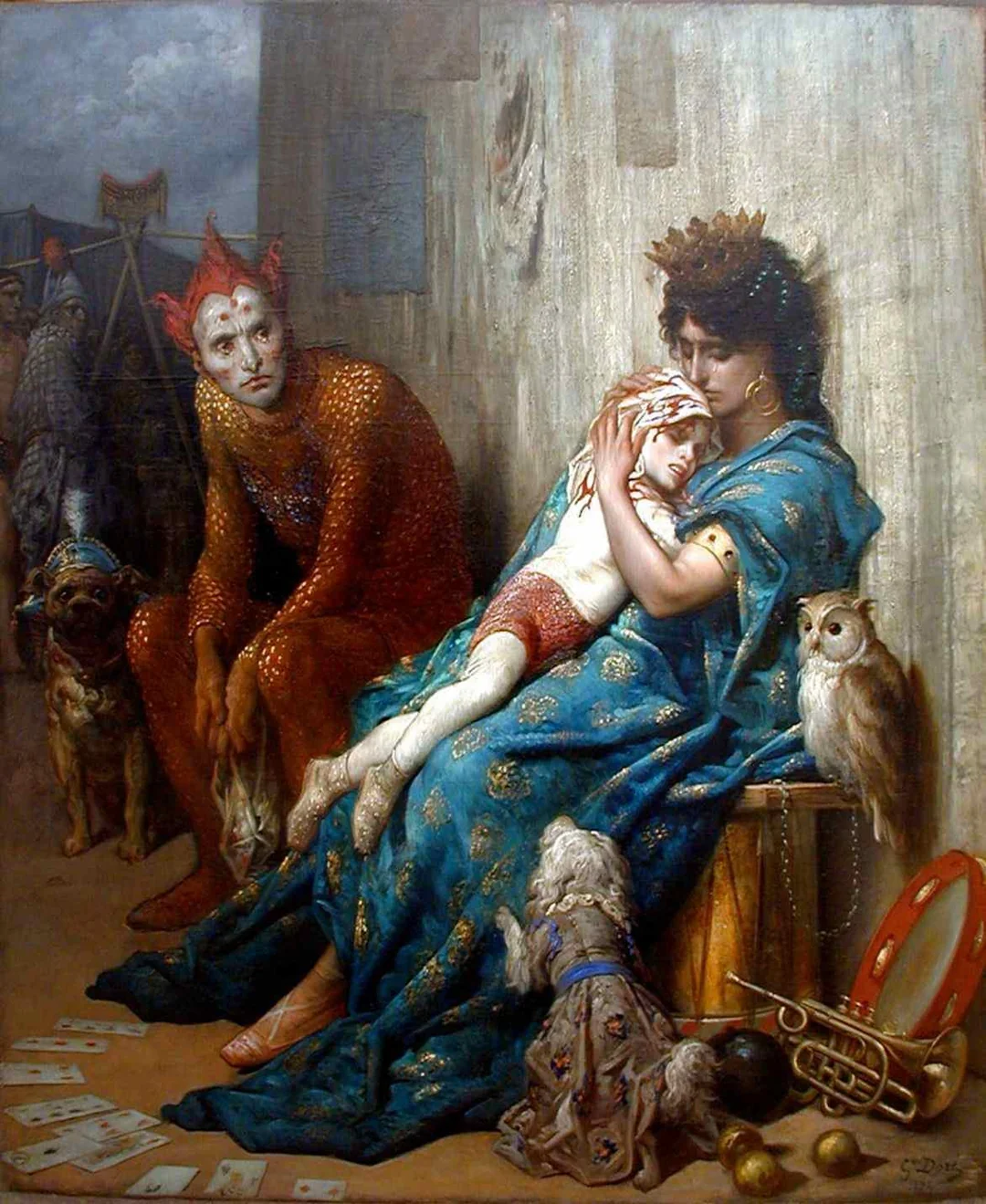Gustave Doré, a master of both illustration and painting, is renowned for his ability to convey deep emotion and vivid storytelling through his art. Among his many works, the painting "Les Saltimbanques," created in 1874, stands out as a hauntingly beautiful depiction of tragedy. This artwork portrays a family of street performers, known as saltimbanques, mourning the critical injury of their child after a tightrope walking accident. Through this poignant scene, Doré explores themes of grief, loss, and the often-overlooked struggles of itinerant entertainers in 19th-century France.
The Scene of Despair
"Les Saltimbanques" captures a moment of profound sorrow. The painting shows a group of street performers gathered around the lifeless or critically injured body of a child, who has just suffered a tragic accident while performing. The performers, dressed in the colorful but worn costumes typical of their trade, are enveloped in an atmosphere of grief. Their faces, marked by deep lines of anguish, convey a raw and palpable sense of despair.
The setting is likely a modest outdoor area, perhaps a street corner or a small public space, where these entertainers would have performed for meager earnings. The stark contrast between the bright costumes and the somber mood of the scene highlights the precarious existence of these performers, who lived on the margins of society, dependent on the whims of the crowd for their livelihood.
Doré's Mastery of Light and Shadow
Gustave Doré's skillful use of light and shadow in "Les Saltimbanques" plays a crucial role in conveying the emotional depth of the scene. The central figure of the injured child is bathed in a soft, almost ethereal light, drawing the viewer's eye to the focal point of the painting. This use of light not only emphasizes the tragedy of the moment but also adds a sense of vulnerability to the child, heightening the emotional impact of the scene.
The surrounding figures are cast in varying degrees of shadow, their faces partially obscured, which serves to amplify the somber atmosphere. The interplay of light and dark in the painting reflects the dual nature of the performers' lives—moments of joy and color interspersed with hardship and sorrow.
A Commentary on the Human Condition
"Les Saltimbanques" is more than just a depiction of a tragic accident; it is a profound commentary on the human condition. Doré uses the plight of the saltimbanques to explore themes of suffering, resilience, and the fragility of life. The performers, who bring joy to others through their art, are shown here in a moment of deep personal tragedy, underscoring the often overlooked hardships they endure.
In 19th-century France, street performers were a common sight, yet they occupied a precarious social position. They were both celebrated for their entertainment and marginalized for their unconventional lifestyle. Doré's painting brings attention to this paradox, offering a sympathetic portrayal of the saltimbanques as real people with their own sorrows and struggles.
The Legacy of "Les Saltimbanques"
"Les Saltimbanques" remains one of Gustave Doré's most emotionally charged works. Its haunting beauty lies in its ability to evoke a deep emotional response from the viewer, compelling us to reflect on the fragility of life and the often unseen struggles of those who live on the margins of society. Through this painting, Doré not only captures a moment of personal tragedy but also immortalizes the resilience of the human spirit in the face of adversity.
In the broader context of art history, "Les Saltimbanques" contributes to the rich tradition of artworks that explore the lives of marginalized groups. Doré's sympathetic portrayal of the saltimbanques aligns with the works of other artists who sought to give voice to the voiceless and to highlight the dignity of those often overlooked by society.
Gustave Doré's "Les Saltimbanques" is a powerful and moving work of art that continues to resonate with audiences today. Through his masterful use of light and shadow, Doré captures the deep sorrow of a family of street performers in the wake of a tragic accident, while also offering a poignant commentary on the human condition. The painting stands as a testament to the resilience of the human spirit and the enduring power of art to convey the complexities of life.








